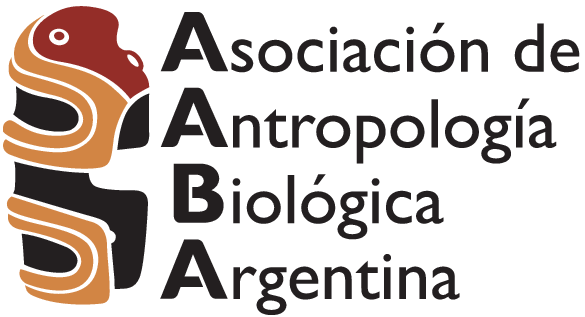Tamaño corporal y temperatura en poblaciones cazadoras recolectoras del Holoceno tardío de Pampa y Patagonia/Body size and temperature in the late Holocene hunter-gatherers from Pampa and Patagonia
Resumen
RESUMEN El objetivo de este trabajo es describir los patrones de variación del tamaño corporal de las poblaciones del Holoceno tardío de Pampa y Patagonia Continental con el fi n de discutir los procesos evolutivos que los habrían modelado. La hipótesis nula indica la acción de procesos evolutivos aleatorios y la alternativa plantea la acción de procesos no aleatorios, como la selección direccional o fenómenos de plasticidad fenotípica relacionados con la temperatura. Se combinaron métodos comparativos espaciales (correlación simple y partición de la variación) con aquellos derivados de la genética cuantitativa (análisis de tasa de divergencia). Asimismo, se evaluó la correspondencia con expectativas biológicas derivadas de estudios experimentales. Las dimensiones del fémur fueron utilizadas como proxies del tamaño a través de variables morfométricas tradicionales. Los resultados indican un ajuste a un gradiente nortesur que se acopla al gradiente climático en el mismo sentido: a medida que aumenta la latitud, disminuye la temperatura y aumenta el tamaño, rechazando la hipótesis nula. Se explican las diferencias en tamaño principalmente por la interacción entre ambiente y espacio, interpretando un efecto común de ambas variables. El patrón descrito se ajusta a un modelo de aumento del tamaño, que implica una reducción de la pérdida de calor a partir de la disminución de la proporción superficie/volumen. Por lo tanto, la divergencia en el tamaño corporal con el clima podría explicarse como resultado de la selección direccional vinculada a las bajas temperaturas, incrementándose el tamaño medio de los individuos con la disminución de la temperatura.
ABSTRACT The goal of this work is to describe the patterns of body size variation in Late Holocene human populations of Pampa and Continental Patagonia in order to discuss the evolutionary processes which may have shaped them. The null hypothesis indicates that random evolutionary processes would explain this variation, while the alternative hypothesis refers to non-random processes, like directional selection or phenotypic plasticity, linked to temperature. Spatial comparative methods (simple correlation and variation partition analysis) were combined with those derived from quantitative genetics (divergence rate analysis). Also, the agreement between observed variation and biological expectations from experimental studies was evaluated. Femur dimensions were used as proxies of size through traditional morphometrics. The results suggest an adjustment to a north-south gradient that couples a climatic gradient: higher latitudes are associated with lower temperatures and larger body sizes, rejecting the null hypothesis. Differences in size are mainly explained in terms of the interaction between environment and space; therefore, there is a common effect between both. The relevance of ecologic factors on body size divergence was corroborated after the results of divergence rate the analysis. The pattern fits a model of body size increase with the consequent reduction in the loss of heat due to a decrease in the surface area/volume ratio. In this way, divergence in body size with respect to climate could be explained as the result of directional selection associated with cold temperatures, so that the average size of individuals increased with lower temperatures.
Descargas
Referencias
Barrientos G, Béguelin M. 2001. Biometría del esqueleto postcraneal en muestras del Holoceno tardío de la cuenca del Lago Salitroso (Provincia de Santa Cruz). Revista Argentina de Antropología Biológica 3:101.
Béguelin M. 2009a. Variación geográfi ca en la morfología del esqueleto postcraneal de las poblaciones humanas prehispánicas de Pampa y Patagonia: una aproximación morfométrica. Tesis Doctoral Inédita. La Plata: Universidad Nacional de La Plata.
Béguelin M. 2009b. Stature estimation in a Central Patagonian prehispanic population: development of new models considering specifi c body proportions. International Journal of Osteoarchaeology. En prensa.
Béguelin M, Barrientos G. 2006. Variación morfométrica postcraneal en muestras tardías de restos humanos de Patagonia: una aproximación biogeográfi ca. Intersecciones en Antropología 7:49-62.
Béguelin M, Gonzalez PN. 2008. Estimación del sexo en poblaciones sudamericanas mediante funciones discriminantes para el fémur. Revista Argentina de Antropología Biológica 10:55-70.
Bergmann C. 1847. Uber die verhaltniesse der warmeokonomie der thiere zu ihrer grosse. Gottingen Studien 1:595-708.
Bernal V. 2008. Procesos de diferenciación biológica entre poblaciones humanas del Holoceno Tardío de Patagonia. Una aproximación desde la variación métrica dental. Tesis Doctoral Inédita. La Plata: Universidad Nacional de La Plata.
Bernal V, Perez SI, Gonzalez PN. 2006. Variation and causal factors of craniofacial robusticity in Patagonian hunter-gatherers from late Holocene. American Journal of Human Biology 18:748-765.
Bernal V, Perez SI, Gonzalez PN, Sardi ML, Pucciarelli HM. 2010. Spatial patterns and evolutionary processes in southern South America: a study of dental morphometric variation. American Journal of Physical Anthropology 142(1):95-104.
Buikstra JE, Ubelaker D. 1994. Standards for data collection from human skeletal remains. Fayetteville, AR: Arkansas Archeological Survey.
Desdevises Y, Legendre P, Azouzi L, Morand S. 2003. Quantifying phylogenetically-structured environmental variation. Evolution 57:2647-2652.
Eller E. 1999. Population substructure and isolation by distance in three continental regions. American Journal of Physical Anthropology 108:147-159.
Fenner JN. 2005. Cross-cultural estimation of the human generation interval for use in genetics-based population divergence studies. American Journal of Physical Anthropology 128:415-423.
Hernández M, García-Moro C, Lalueza C. 1997. Antropometría del esqueleto postcraneal de los Aonikenk. Anales del Instituto de la Patagonia. Serie Ciencias Humanas 25:35-44.
Holliday TW. 1995. Body size and proportions in the Late Pleistocene Western Old World and the origins of modern humans. Tesis Doctoral.Albuquerque: University of New Mexico.
Katzmarzyk PT, Leonard WR. 1998. Climatic infl uences on human body size and proportions: ecological adaptations and secular trends. American Journal of Physical Anthropology 106:483-503.
Lande R. 1977. Statistical tests for natural selection on quantitative characters. Evolution 31:442-444.
Legendre P, Legendre L. 2003. Numerical ecology. Amsterdam: Elsevier Science BV.
Lemos B, Marroig G, Cerqueira R. 2001. Evolutionary rates and stabilizing selection in large-bodied opossum skulls (Didelphimorphia: Didelphidae). Journal of Zoology 255:181-189.
Lynch M. 1990. The rate of morphological evolution in mammals from the standpoint of the neutral expectation. American Naturalist 136:727-741.
Martin R, Saller K. 1957. Lehrbuch der Anthropologie. Band 1. Stutgart: Gustav Fischer Verlag.
McNab BK. 1983. Energetics, body size, and the limits to endothermy. Journal of Zoology 99:1-29.
McNab BK. 1990. The physiological signifi cance of body size. En: Damuth J, MacFadden BJ, editores. Body size in mammalian paleobiology: estimation and biological implications. New York: Cambridge University Press. p 11-23.
Moraga ML, Rocco P, Miquel JF, Nervi F, Llop E, Chakraborty R, Rothhammer F, Carvallo P. 2000.
Mitochondrial DNA polymorphisms in Chilean Aboriginal Populations: Implications for the peopling of the southern cone of the continent. American Journal of Physical Anthropology 113:19-29.
Pearson OM, Millones M. 2005. Rasgos esqueletales de adaptación al clima y la actividad entre los habitantes aborígenes de Tierra del Fuego. Magallania 33:37-50.
Politis GG, Madrid P. 2001. Arqueología pampeana: estado actual y perspectivas. En: Berberian E, Nielsen A, editores. Historia argentina prehispánica. Córdoba: Editorial Brujas. p 737-814.
Raxter MH, Auerbach BM, Ruff CB. 2006. Revision of the fully technique for estimating statures. American Journal of Physical Anthropology 130:374-384.
Relethford JH. 1994. Craniometric variation among modern human populations. American Journal of Physical Anthropology 95:53-62.
Riesenfeld A. 1973. The effect of extreme temperatures and starvation on the body proportions of the rat. American Journal of Physical Anthropology 39:427-460.
Riesenfeld A. 1981. The role of body mass in thermoregulation. American Journal of Physical Anthropology 55:95-99.
Roberts DF. 1953 Body weight, race and climate. American Journal of Physical Anthropololgy 11:533-558.
Roseman CC. 2004. Detecting interregionally diversifying natural selection on modern human cranial form by using matched molecular and morphometric data. Proceedings of the National Academy of Sciences 101:12824-12829.
Ruff CB. 1994. Morphological adaptation to climate in modern and fossil hominids. Yearbook of Physical Anthropology 37:65-107.
Schafer JL, Graham JW. 2002. Missing data: Our view of the state of the art. Psychological Methods 7:147-177.
Schreider E. 1964. Ecological rules, body heat regulation and human evolution. Evolution 18:1-9.
Serrat M. 2007. Environmentally-determined tissue temperature modulates extremity growth in mammals: a potential comprehensive explanation of allen’s rule. Tesis Doctoral. USA: Kent State University.
Serrat M, King D, Lovejoy CO. 2008. Temperature regulates limb length in homeotherms by directly modulating cartilage growth. Proceedings of the National Academy of Sciences 105:19347-19352.
Steele J, Politis GG. 2008. AMS 14C dating of early human occupation of southern South America. Journal of Archaeological Science 36:419-429.
Stock JT. 2002. Climatic and behavioral infl uences on postcranial robusticity among holocene foragers. Canada: University of Toronto.
Stock JT. 2006. Hunter-gatherer postcranial robusticity relative to patterns of mobility, climatic adaptation, and selection for tissue economy. American Journal of Physical Anthropololgy 131:194-204.
Trotter M. 1970. Estimation of stature from intact long limb bones. En: Stewart TD, editor. Personal indentifi cation in mass disasters. Washington: Smithsonian Institute. p 71-83.
Descargas
Publicado
Número
Sección
Licencia
La RAAB es una revista de acceso abierto tipo diamante. No se aplican cargos para la lectura, el envío de los trabajos ni tampoco para su procesamiento. Asímismo, los autores mantienen el copyright sobre sus trabajos así como también los derechos de publicación sin restricciones.






























